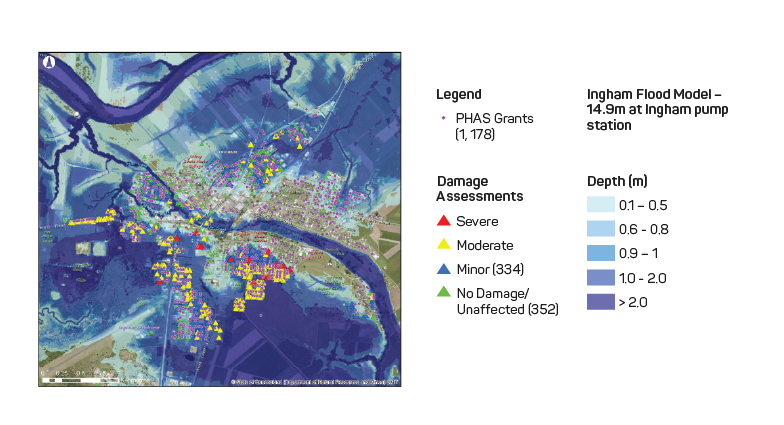In 2018, 48 of Queensland’s 77 local government areas received natural disaster assistance following multiple flood events. The Queensland Reconstruction Authority, Australia’s only permanent disaster recovery organisation, reflects on recovery successes and challenges from these events.
In early 2018, more than half of Queensland was hit by damaging storms as well as Tropical Cyclone Nora, causing multiple flooding events. The effects of these weather events were widespread and deeply felt. Geographically, these severe weather events stretched from Maranoa in Queensland’s south-west to the Northern Territory border. Five separate rain events drenched communities across northern, central and western Queensland, causing widespread flooding. While these Queensland communities continue to recover and rebuild from these events, they are also preparing for the upcoming severe weather season.
The key to successful recovery relies on a communityled approach that is supported by local governments and state agencies that is focused on tailored local solutions. Local governments, through their disaster management groups and local recovery groups, are best placed to understand and identify recovery needs and lead local recovery activities.
Recovery plans have been developed by local recovery groups in the most severely affected local government areas to support recovery. The recovery plans for Hinchinbrook Shire Council and Cassowary Coast Regional Council are dynamic and were created to meet the emerging needs and priorities of these communities.
Local government areas throughout Queensland are continuing recovery efforts focused on reconstruction of essential public assets, with the Queensland Reconstruction Authority administering Natural Disaster Relief and Recovery Arrangements funding and acquittal processes.
Recovery activities and reporting
We recognise that connected communities are resilient communities and those communities respond and recover well in good as well as difficult times. At the state level, the progress of local recovery is supported by five functional recovery groups: human and social, economic, environment, building and roads and transport.
Following the severe weather events in 2018, we worked with the state-level functional recovery groups, the effected local governments as well as recovery partners to develop the Queensland 2018 Severe Storm, Cyclone and Flood Events Recovery Plan. This plan frames, defines and develops the understanding of recovery needs in disaster-impacted regions as determined by impact assessments.
The plan was distributed to all functional recovery groups, Queensland Fire and Emergency Services, Queensland Police Service, the Department of the Premier and Cabinet, the Local Government Association of Queensland as well as the mayors of Hinchinbrook Shire Council and Cassowary Regional Council for review. Feedback was incorporated accordingly.
The plan is a framework for the coordination of recovery efforts, including reconstruction and rebuilding of communities, economies and the environment so they are stronger and more resilient. It promotes resilience through recovery activities and encourages communities to learn from experiences and adapt to new circumstances.
Complexity in recovery metrics and mapping
Immediately following the 2018 weather events, recovery assistance included collection and mapping of geocoded damage assessment data (see Figure 1). The data and associated understandings of the impacts on communities were shared with the relevant local governments and state-level agencies to inform coordinated recovery assistance and long-term planning. This data allowed us to quantify and report on the impacts and monitor recovery progress. Follow-up damage assessments are conducted three, six, nine and 12 months after the events as required.

Figure 1: Layered GIS mapping information following the 2018 weather events show damage assessments, flood model and Personal Hardship Assistance Scheme grants at Ingham.
An understanding of the pre-disaster state of affected communities is crucial to the effectiveness of recovery reporting. There are formal and informal approaches to post-event damage assessments, impact assessments and planning processes. During an event, this data collection is coordinated by the State Disaster Coordination Group.
Standardisation of government disaster recovery data presents some challenges and requires consideration of functional recovery reporting requirements, the National Impact Assessment Model and the Seven Global Targets from the Sendai Framework for Disaster Risk Reduction 2015-2030. Metrics must capture service delivery in the relief and recovery phases of an event and the outcomes of that delivery. Recovery metrics and outcomes are continually feeding into the development of community profiles and the ‘new’ status quo. These learnings make it logical to have a cyclical approach to disaster recovery reporting programs.
Queensland’s recovery reporting is undertaken by the Queensland Reconstruction Authority in partnership with the state agencies responsible for functional recovery. This includes identifying an appropriate impact assessment model, clear metrics, outcomes-focused reporting and a suitable technical solution with GIS integration.
Capability development
We have recently implemented a Recovery Capability Development Project to support localised recovery. The aim is to increase confidence in community-led recovery processes, upskill disaster management teams to deliver recovery operations and plans, provide a coordinated structure for recovery and increase capabilities to develop and implement local recovery plans.
Community recovery from disasters can be a complex and lengthy process and different communities recover at different rates and in different ways. The Recovery Capability Development Project is helping improve how communities prepare for, respond to and recover from disasters. The Queensland Reconstruction Authority is delivering training and exercises focused on community participation in recovery for partners including Queensland Fire and Emergency Services, Queensland Police Service and the Department of Communities, Disability Services and Seniors. The project is being delivered in 21 Queensland local government areas as phase one of a state-wide rollout of recovery capability training.
Resilient Queensland – Delivering the Queensland Strategy for Disaster Resilience 2018-21, was launched in May 2018. The strategy was developed in consultation with state agencies, the private sector and local governments with a shared vision to make Queensland the most disaster resilient state in Australia. We will achieve this through realising the strategy’s objectives and future actions, implementing a whole-ofgovernment response to disaster resilience to increase the understanding of risk, continued investment in community resilience, improving how we respond and recover from disasters and ensuring resilience becomes business-as-usual for all parts of the community.


